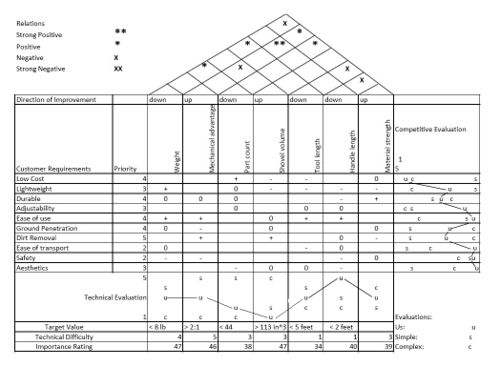Post Hole Digger: Additional Information
From DDL Wiki
(New page: =Quality Function Deployment= =Mechanical Analysis= ==Part 1:Report 3== ==Part 2:Additional Analysis==) |
(→Quality Function Deployment) |
||
| Line 1: | Line 1: | ||
=Quality Function Deployment= | =Quality Function Deployment= | ||
| + | =Quality Function Deployment = | ||
| + | [[Image:team2QFD.JPG|thumb|bottom|500px|Figure 1: QFD or 'House of Quality' for our Post Hole Digger]] | ||
| + | [[Quality function deployment]], or QFD, is a means of ensuring that the needs or 'voice' of the customer are considered when designing a product and also allows for comparison to current competitors and product specifications. Essentially, the QFD is a matrix that relates the needs of the customer to the product specifications and helps to ensure the creation of a high quality product. The most common type of QFD and the one we have used in our analysis is a product planning matrix or a 'house of quality'. The main part of a Product Planning Matrix are its inner contents, which are the customer requirements and their associated priority on the left and the product design requirements on the upper columns. At the intersection of these, each is given a rating as having either a strong, weak, or moderate relationship. On the far right column is the competitive evaluation, where the current product is evaluated against the current competition in terms of the customer requirements. Along the bottom, a similar comparison is made in terms of the product requirements, and target values are set for these technical parameters. At the bottom, we summarize the importance of each of the product requirements, to give us an idea of which areas of the product deserve the most attention. Finally, the top of the Product Planning Matrix summarizes the interactions and relations between the different product requirements as either positive or negative and moderate or strong. This feature's distinctive appearance helps give the matrix it's 'house of quality' nickname. | ||
| + | |||
| + | For additional information on our QFD analysis, please see [[Post Hole Digger: Additional Information]]. | ||
| + | ==Conclusions== | ||
| + | The Quality Function Deployment for our product is shown below; as noted above, we chose to use a Product Planning Matrix or 'House of Quality'. Our QFD helped to reinforce initial thoughts on customer desires, place targets for a number of quantitative goals, and determine how we compared to the competition. Most of the results of this were somewhat expected, namely that consumers are most interested in ease of use(mechanical advantage), light weight, and high shovel volume, all factors that contribute to the speed at which digging can occur. Our final design meets or exceeds our initial goals in nearly all areas, and consistently places us on pace with or ahead of the competition. It should be noted that not all results from our QFD were taken verbatim. For example, although tool and handle length were considerations of ours in designing our product, our target values were never taken as necessary goals and instead we attempted to create the best overall product. | ||
=Mechanical Analysis= | =Mechanical Analysis= | ||
Revision as of 18:55, 6 December 2008
Contents |
Quality Function Deployment
Quality Function Deployment
Quality function deployment, or QFD, is a means of ensuring that the needs or 'voice' of the customer are considered when designing a product and also allows for comparison to current competitors and product specifications. Essentially, the QFD is a matrix that relates the needs of the customer to the product specifications and helps to ensure the creation of a high quality product. The most common type of QFD and the one we have used in our analysis is a product planning matrix or a 'house of quality'. The main part of a Product Planning Matrix are its inner contents, which are the customer requirements and their associated priority on the left and the product design requirements on the upper columns. At the intersection of these, each is given a rating as having either a strong, weak, or moderate relationship. On the far right column is the competitive evaluation, where the current product is evaluated against the current competition in terms of the customer requirements. Along the bottom, a similar comparison is made in terms of the product requirements, and target values are set for these technical parameters. At the bottom, we summarize the importance of each of the product requirements, to give us an idea of which areas of the product deserve the most attention. Finally, the top of the Product Planning Matrix summarizes the interactions and relations between the different product requirements as either positive or negative and moderate or strong. This feature's distinctive appearance helps give the matrix it's 'house of quality' nickname.
For additional information on our QFD analysis, please see Post Hole Digger: Additional Information.
Conclusions
The Quality Function Deployment for our product is shown below; as noted above, we chose to use a Product Planning Matrix or 'House of Quality'. Our QFD helped to reinforce initial thoughts on customer desires, place targets for a number of quantitative goals, and determine how we compared to the competition. Most of the results of this were somewhat expected, namely that consumers are most interested in ease of use(mechanical advantage), light weight, and high shovel volume, all factors that contribute to the speed at which digging can occur. Our final design meets or exceeds our initial goals in nearly all areas, and consistently places us on pace with or ahead of the competition. It should be noted that not all results from our QFD were taken verbatim. For example, although tool and handle length were considerations of ours in designing our product, our target values were never taken as necessary goals and instead we attempted to create the best overall product.

